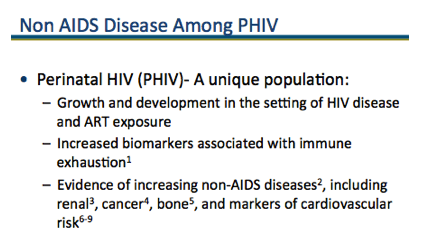 |
 |
 |
| |
Prevalence of systemic hypertension among HIV-infected and HIV-uninfected young adults - Young Adults Perinatally Infected With HIV Run Higher Hypertension Risk
|
| |
| |
Young Adults Perinatally Infected With HIV Run Higher Hypertension Risk
"perinatal HIV infection appears to be an independent risk factor for hypertension. Chronic kidney disease in this group partly accounts for this association and requires further study"

IDWeek2017/IDSA, October 4-8, 2017, San Diego
Mark Mascolini
People perinatally infected with HIV and now in their 20s had almost 5-fold higher odds of hypertension than uninfected matched controls [1]. But young adults with behaviorally acquired HIV did not run a higher risk of hypertension than the uninfected group.
University of Maryland researchers noted that young people who acquired HIV around the time of birth now have renal, bone, and malignant disease rates beyond their years, as well as rising levels of cardiovascular disease markers. Older adults with nonperinatal (behaviorally acquired) HIV have hypertension rates ranging from 8% to 48%. Earlier work by the Maryland group charted a hypertension prevalence of 26.6% in 106 people with perinatally acquired HIV [2], but that analysis relied on provider diagnosis and had no comparison groups.
The new analysis involved all perinatally infected people now 18 to 29 years old and in care in University of Maryland clinics. The researchers matched this group by sex and race to young adults with nonperinatal HIV infection and to people without HIV. The investigators then determined hypertension prevalence in each group, defining hypertension as two or more systolic or diastolic readings at or above 140 or 90 mmHg separated by at least 3 months or as a record of an antihypertensive prescription. They used multivariable logistic regression to determine adjusted prevalence odds ratios (aPOR) comparing perinatally and nonperinatally infected participants to the HIV-uninfected group.
The perinatal, nonperinatal, and HIV-negative groups each included 108 people, 58% of them women, with a median age of 24. Almost all study participants--95% in each group--were black. Perinatally infected people were significantly more likely than people with nonperinatal HIV to have chronic kidney disease. The nonperinatal HIV group had significantly higher rates of tobacco use, alcohol use, and other drug use than the other two groups. HIV-negative people were significantly more likely than the two HIV groups to be obese or have a family history of hypertension.
Large majorities in both HIV groups were taking antiretroviral therapy, and about 50% in both groups had an undetectable viral load. Compared with the behaviorally infected group, the perinatal group had a longer average HIV duration (about 20 versus 5 years), a longer ART duration (about 20 years versus 2 years), but also a longer time from HIV diagnosis to starting ART (about 5 years versus 2 years).
Hypertension prevalence measured 23.1% in the perinatal HIV group, 10.2% in the nonperinatal HIV group, and 8.3% in the HIV-negative group. In an analysis adjusted for the matching variables--sex and race--people with HIV had more than 3-fold higher odds of hypertension than HIV-negative people (POR 3.4, 95% confidence interval [CI] 1.48 to 7.66). People with nonperinatal HIV had almost 3-fold higher odds of hypertension than the HIV-negative group, but this association fell short of statistical significance (POR 2.9, 95% CI 0.92 to 9.72). Young adults with perinatally acquired HIV had almost 3 times higher odds of hypertension than the nonperinatal-HIV group (POR 2.7, 95% CI 1.24 to 5.80).
An analysis adjusted for sex, race, family history of hypertension, and chronic kidney disease determined that people with perinatally acquired HIV had almost 5-fold higher odds of hypertension than HIV-negative people (aPOR 4.7, 95% CI 1.9 to 11.5). But the nonperinatal HIV group did not have independently higher odds of hypertension than the HIV-negative group (aPOR 1.7, 95% CI 0.7 to 4.6). Further analysis determined that chronic kidney disease partially mediated the higher odds of hypertension among people with perinatally acquired HIV.
The University of Maryland investigators concluded that perinatal HIV infection appears to be an independent risk factor for hypertension. Chronic kidney disease in this group partly accounts for this association and requires further study.
References
1. Ryscavage P, Still W, Nyemba V, Stafford K. Prevalence of systemic hypertension among HIV-infected and HIV-uninfected young adults. IDWeek2017/IDSA. October 4-8, 2017. San Diego. Abstract 1815.
2. Ryscavage P, Macharia T, Trinidad LR, Lovelace S, Tepper V, Redfield R. Patterns of systemic hypertension among adults with perinatally acquired HIV. J Int Assoc Provid AIDS Care. 2017;16:3-7. https://www.ncbi.nlm.nih.gov/pubmed/27644759
|
| |
|
 |
 |
|
|